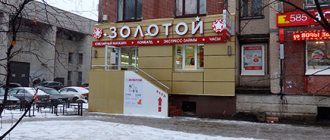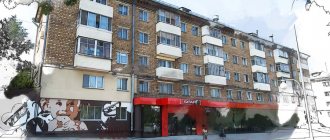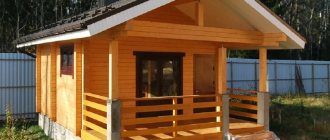Is it possible to transfer an apartment to non-residential premises: legislation
When deciding to transfer residential premises to non-residential premises in St. Petersburg, Moscow and any other city, you need to take into account several laws:
- Ch. 3 Residential Complex of the Russian Federation. Contains the conditions, procedure and grounds for refusing to change the status of housing.
- SP 54.13330.2011. You need to focus on them when remodeling. In the future, the commission will check whether the premises meet the established requirements.
- Decree of the Government of the Russian Federation of April 28, 2005 N 266 “On approval of the application form...”. Contains a unified application form for redevelopment.
- Federal Law “Technical Regulations on Fire Safety Requirements” dated July 22, 2008 N 123-FZ. It must be observed when performing construction work.
Note: regional authorities may issue their own legislation, making changes or additions to the transfer procedure and premises requirements.
Types of residential premises
According to Art. 16 of the Housing Code of the Russian Federation, there are several types of residential premises:
- Private residential buildings and parts of houses.
- Apartments and parts of apartments.
- Rooms.
It is important to take into account that it will not be possible to transfer part of an apartment, house or a separate room to non-residential premises. This is technically impossible, because... all requirements will not be met. Only complete housing that meets all criteria is transferred to non-residential status.
How to convert a garage into residential or non-residential premises?
What is non-residential premises - definition according to the Housing Code of the Russian Federation
When might it be necessary to transfer an apartment to non-residential premises?
Most often, people transfer real estate from residential to non-residential for several reasons:
- Conducting business activities. According to Art. 17 of the Housing Code of the Russian Federation, in the apartment you can engage in tutoring, work as a freelancer, or engage in other professional activities, if this does not violate the rights and interests of neighbors. But it won’t be possible to open an industrial production or a hotel in housing; you need to change the status of the premises to non-residential.
- In the region there is a ban on certain types of business activities in apartments and houses. To deal with them, you need to transfer the housing to non-residential status.
Note! In some regions, it is prohibited to open stores selling alcoholic beverages. It is best to check local legal requirements in advance.
Approvals after completion of work
Construction work in the future apartment is carried out strictly in accordance with the project. After completion of the work, you must contact the Moscow Housing Institute to receive an acceptance certificate. He will confirm that there are no complaints about compliance with safety standards, and all work complies with the original project.
You can contact the cadastral engineer with the acceptance certificate. This specialist will inspect all the premises of the apartment, take measurements, and prepare a technical plan. Based on this document, Rosreestr will conduct cadastral registration and enter into the Unified State Register of Real Estate new data on the status of the premises and its characteristics. The completion of the procedure will be the issuance of an extract from the Unified State Register. After this, the non-residential premises will officially become an apartment in the legal sense, and it will be possible to register at its address.
Expert commentary. Procedures after completion of construction work are no less important, as they will confirm the change in the legal status of the premises. The Smart Way company has cadastral engineers who will quickly prepare a technical plan. We will also help you pass the Rosreestr and obtain an extract from the Unified State Register of Real Estate.
The change in the status of the premises to residential will be reflected in the USRN extract.
Conditions for transfer to non-residential premises
To transfer a residential building or apartment to non-residential premises, several conditions must be met:
- Obtain the consent of all owners of adjacent housing.
- You cannot change the status of an object for religious activities, regardless of religion.
- Obtain the consent of all owners of the apartment building. It is drawn up based on the results of the meeting.
- It will not be possible to transfer the status to non-residential if the property is used under a social tenancy agreement or belongs to the category of social housing.
- Only the owner, whose rights are confirmed by documents, has the right to execute the transfer.
- It will not be possible to transfer housing if it is under arrest, pledged, or encumbered with other rights of third parties to it.
- If the property was purchased during marriage, the transfer will require the consent of the spouse.
Legal advice: it is better to discuss the issue of transfer with your neighbors in advance before formalizing the documents. A general meeting is necessary in any case, but if there are many opponents, having learned about them before voting, you have a better chance of finding those who will not mind and agreeing that they will definitely come to the meeting.
We comply with all necessary legal regulations
Converting an apartment to commercial real estate is not possible without meeting the following legal requirements:
- The housing must be owned by the applicant. This, of course, must be a legal entity. It is necessary to have written confirmation that the apartment is owned. It could be:
- will;
- gift agreement;
- registration certificate.
- This apartment should not be taken out on credit or used as collateral. Supervisory authorities are very careful to ensure that the property is legally “clean”. She should not be involved in any fraud under any circumstances.
- An apartment can be transferred from residential to non-residential status only in full, and in no case partially.
- The owner must check out of the apartment before starting the procedure for changing its status. According to the law, no one can be registered in a non-residential premises, and no one can live there permanently.
- If any illegal alterations have been made to the apartment, they must be legalized without fail. Otherwise, the transfer will simply not be given the go-ahead.
Technical requirements for the premises
There are also technical requirements for transferred residential real estate that must also be observed:
- The apartment should be located on the first floor. It is also possible to transfer apartments on the upper floors, but only if all the premises below are non-residential.
- It is necessary to equip a separate entrance. There is no point in doing it before the redevelopment and approval of the transfer; it is better to start arranging it in the process. There must be a direct entrance to the premises; use of the entrance is not allowed.
- The object must be completely isolated.
- You must not create obstacles to the use of common property: staircases, elevators, etc.
- If the building is classified as a cultural heritage site, the redevelopment must be approved through the cultural committee or other institution in the region.
- If the facade is affected during construction work, coordination with the architecture committee is required.
Note! If a residential private house is transferred to non-residential premises, you need to look at the type of permitted use of the land. For example, commercial activities are prohibited on certain categories of land. In this case, you will first have to change the status of the site, and then deal with the premises.
Transferring residential premises to non-residential premises: step-by-step instructions
To convert a residential apartment to non-residential real estate you need:
- Get a redevelopment project.
- Coordinate changes with neighbors.
- Submit documents to the administration for approval of the redevelopment.
- Carry out construction work.
- Receive an inspection report and a conclusion on the compliance of the premises with the requirements.
- Receive a transfer decision.
- Make adjustments to the Unified State Register.
Let's look at each step in more detail.
Step 1: registration of redevelopment
This means ordering a redevelopment project. It is better to do this before the meeting of the owners of the apartment building, so that people understand what changes are planned to be made. If controversial issues arise, they can be resolved directly at the meeting.
The project is formalized in an organization that has SRO approval. The specialist will need technical documents for housing, as well as access to it. He will examine the premises and then make a design. The document will indicate the planned technical changes, a description of all types of work, the purpose of the redevelopment (change in the status of the facility), and measures to ensure fire safety.
Note: the project production period is indicated in the contract. Usually this is 2-3 weeks.
Step 2: coordination with neighbors
First you need to coordinate the changes with the owners of the adjacent apartments: on the side, above and below. Consent is drawn up in simple written form. After this, everything is agreed upon with the other homeowners in the apartment building at a meeting.
What should be done:
- Notify apartment owners of the upcoming meeting, indicating the agenda. Notifications are sent no later than 14 days before the scheduled date. You can obtain information about all owners by ordering an extract from the Unified State Register for an apartment building in Rosreestr. It will be done in 3-4 days, it costs 350 rubles.
- To hold a meeting. At least 50% of the owners must be present. You can also involve the HOA. At the meeting, the agenda is announced and the redevelopment project is shown.
- Conduct a vote and, based on the results, draw up a protocol indicating all participants in the meeting.
- Prepare a participant registration sheet and protocol. These documents will be needed at the next stage.
Note! The meeting can be held in absentia. But to do this, the owner of the transferred premises will have to visit all the residents and personally answer all questions about the agenda. To attract more allies, it is worth explaining to people why opening a commercial organization in their home is beneficial. If possible, the owner of the premises can “appease” the other owners by promising to improve the yard area.
Step 3: submitting documents to the administration
To transfer residential premises to non-residential premises, the following documents must be submitted to the administration:
- application for transfer;
- application for redevelopment;
- owner's passport;
- MKD floor plan;
- extract from the Unified State Register of Real Estate;
- floor plan;
- redevelopment project;
- technical report on the condition of load-bearing walls;
- written consent of the owners of adjacent premises;
- minutes of the general meeting of owners;
- extract from the Unified State Register of Real Estate.
Legal advice: the administration may additionally request a registration certificate and documents on the basis of which ownership rights are registered (sale and purchase agreement, exchange, donation, etc.). It's better to introduce them right away.
Contents and sample application for redevelopment
The application is filled out in the prescribed form. What information does it contain:
- The name of the local government body to which it is submitted.
- Full name, address, passport details of the owner-applicant.
- Residential address.
- Request for permission to redevelop according to the attached project.
- Full name, notes on the consent of the remaining owners.
- List of attached documents.
- Date of compilation and signature.
Contents and sample application for transfer of residential premises to non-residential premises
This application contains the same information as in the one presented above, only instead of a request for approval of redevelopment, you need to write that it is necessary to change the status of the object to non-residential.
Sample application
Step 4: Get the solution
Submitted documents are reviewed by the administration for no more than 45 calendar days. During this time, the redevelopment must be agreed upon, a decision or resolution must be drawn up to change the status of the object to non-residential.
Note! The decision of the head of administration is sent to the owner within three days.
Step 4: redevelopment
If the administration has agreed to the redevelopment, construction work can begin. The agreement must be concluded with an organization that has SRO approval. It is important that the work is carried out in accordance with the project, otherwise it will not be accepted.
Step 5: inspection of the premises and receipt of the certificate
When the work is completed, you need to submit a notification to the administration. A commission consisting of employees of the housing department, the Ministry of Emergency Situations, architecture and other departments will check whether the premises meet the established requirements. If there are any shortcomings, they will be given several days to eliminate them. If everything is in order, an acceptance certificate is issued.
Step 6: ordering a technical plan
After signing the acceptance certificate, you need to order a new technical plan from a cadastral engineer with SRO approval. He will inspect the premises and draw up a document containing the main characteristics of the property after redevelopment.
Step 7: making changes to the Unified State Register
All changes must be reflected in the Unified State Register. You need to submit an application directly to Rosreestr or through the MFC; in some regions, an application through State Services is available.
Along with the application, a passport, a resolution on the transfer of the object’s status, an acceptance certificate and a technical plan are submitted.
Note: changes will be made within 5-7 days. As a result, the owner will be given an extract from the Unified State Register of Real Estate, where the premises will already be listed as non-residential.
List of documents
The safety of construction work, compliance with translation requirements and approvals are impossible without documentation. At different stages of the procedure you may need:
- title document for the object (USRN extract, certificate of title, purchase and sale agreement);
- documents from MosgorBTI (technical passport, floor plans for the entrance to the house where the premises being transferred are located);
- decision of all copyright holders for translation (if necessary);
- consent of the owners of adjacent apartments;
- project for redevelopment, reconstruction (in some cases a project for facade work will be needed);
- technical report confirming the safety of work for load-bearing structures of multi-unit buildings;
- minutes of the MKD meeting;
- an application to the DGI for the issuance of a notice of transfer;
- application to the Ministry of Housing for approval of the redevelopment project;
- act of the acceptance committee after completion of work;
- technical plan for the changed characteristics of the premises;
- application for cadastral registration in order to enter new information into the Unified State Register of Real Estate.
The exact list of documents will be determined by our specialists after a preliminary study of the situation and the features of the translation. It is also necessary to issue a power of attorney to simplify the completion of all procedures.
The redevelopment project describes the work after which the non-residential premises will be recognized as an apartment.
How much does it cost to remove an apartment from the housing stock?
The cost of converting residential real estate to commercial consists of the costs of several documents:
- Notarized consent of all owners, if the housing is in shared ownership - from 1,000 rubles. for one document.
- Extract from the Unified State Register – 350 rubles, if ordered electronically on the Rosreestr website.
- Technical plan – from 5,000 rub.
- Redevelopment project – from 15,000 rub.
Note: there are also organizational costs for holding a general meeting. For example, printing notifications and sending letters by Russian Post costs on average 5,000 rubles. It is also necessary to take into account the costs of the redevelopment itself; they depend on the type of changes made, the list of works and the total area of the room.
What does the law say about this?
First of all, you need to refer to the legislative acts of the Russian Federation. Having studied the existing regulatory aspects, one can come to a disappointing conclusion: residential premises must be used only for living in it.
But don't be upset. There is the possibility of converting housing into commercial real estate, which will ultimately allow you to work from your home.
It is very important that the interests of all other residents living in the house are taken into account. Not a single right of theirs should be violated.
Many people mistakenly believe that the consent of all neighbors to transfer housing to commercial real estate is a prerequisite. Actually this is not true. However, if any controversial issues arise, the consent of your neighbors can have a serious impact, moving the arrow of the scale in your favor.
What to do if the transfer of housing stock to non-residential property is refused?
According to Art. 24 of the Housing Code of the Russian Federation, a change in the status of a property may be refused for several reasons:
- Inconsistency of the redevelopment project with the established requirements.
- Failure to submit documents to the administration within the established time limits.
- Submission of an incomplete set of documents.
- Presence of restrictions: bail, arrest.
- Changes in project documentation after a meeting of homeowners in the apartment building.
- Violations of the procedure for holding a general meeting.
- The project specifies work that involves reconstruction: adding an additional room, replacing load-bearing structures.
The refusal is issued in writing and issued to the owner no later than 45 calendar days from the date of registration of the application. It can only be appealed in court.
Legal advice: in order not to go to court, it is easier to take into account the comments in the refusal, eliminate them, and then resubmit the documents. This is not prohibited by law. But if the refusal is not justified, you will have to file an administrative claim. If the court satisfies the requirements, the administration’s decision will be canceled and the residential premises will be transferred to non-residential premises based on the decision.
What costs will you incur during the entire procedure?
Not only time is wasted when obtaining a certificate of transition from residential to non-residential. This will take a lot of money. You will have to spend your money on the following procedures:
- Recalculation of non-residential premises, which is compiled in the BTI. Payment of its cost.
- Preparation of a technical passport.
- State fee for issuing a certificate.
- Notary services for certification of documents for an apartment, execution of a power of attorney.
- Creation of a project for the redevelopment or reconstruction of a premises.
If you follow the outlined sequence of steps, you can arrange the transition of housing to non-residential premises in the shortest possible time and at the lowest cost.
Arbitrage practice
Typically, the administration refuses to transfer housing from residential to non-residential due to the lack of consent of the owners of adjacent premises or the failure to hold a general meeting, or if the redevelopment project does not meet the established requirements.
Here are some examples of decisions in cases challenging administration refusals:
- Decision No. 2A-937/2020 2A-937/2020~M-475/2020 M-475/2020 dated February 28, 2021 in case No. 2A-937/2020. As a result, the court granted the claim, declaring the refusal illegal. The defendant (administration) was obliged to make a decision to transfer the premises to non-residential status and to issue an acceptance committee report on the completion of the redevelopment.
- Decision No. 2A-2855/2019 2A-437/2020 dated February 27, 2021 in case No. 2A-1766/2019~M-1283/2019. The demands were rejected in full.
- Decision No. 2A-102/2020 2A-102/2020~M-27/2020 M-27/2020 dated February 20, 2021 in case No. 2A-102/2020. The administration refused the transfer due to the lack of parking spaces, because... The plaintiff planned to use the premises to open a store. The claims were denied.
Transfer from non-residential to residential and back: list of services
Transferring an apartment to non-residential premises is a responsible process that requires its performer to have deep knowledge and extensive experience in this field. The same can be said about the transfer of non-residential stock to residential. Our company’s specialists cope equally well with both of these tasks. Our employees will perform for you all the necessary tasks that you may encounter when transferring from residential to non-residential and back:
- · Receive the original BTI documents;
- · Develop project documents for translation;
- · Develop a technical report for organizing redevelopment;
- · Conduct a general meeting of owners of premises in the building;
- · Draw up minutes of the general meeting;
- · Coordinate the project with the authorities;
- · Coordinate the gas transfer project (if necessary);
- · Will receive additional electrical power (if necessary);
- · Sign the act of completed reconstruction;
- · Receive updated BTI documents.
Along with the listed paperwork for transferring the premises to non-residential use, we will carry out any repair work in your premises. Our craftsmen will do an excellent job of painting walls and ceilings, laying floor coverings, leveling floors, strengthening openings in load-bearing structures and other work. With our help, you can also obtain SRO approval for repair and design work. Our specialists provide certificates for hidden work.
Lawyer's answers to private questions
I ordered and paid for the redevelopment project, it cost me 30,000 rubles. After this, I organized a meeting of owners, they opposed the transfer of my apartment to the status of non-residential premises. Is it possible to recover expenses from them?
No. Changing the status of a property is the desire of the owner himself. Other owners may be against it, and are not required to reimburse expenses prior to the meeting.
I did the remodeling myself. Now I want to order a project to transfer the apartment to non-residential status. Is it possible to do this?
No. First, a redevelopment project is ordered, then construction work is carried out. Responsibility for illegal redevelopment is provided for under Art. 7.21 of the Code of Administrative Offenses of the Russian Federation, they can be fined up to 2,500 rubles. In addition, on the basis of Art. 29 of the Housing Code of the Russian Federation, the administration has the right to oblige the owner to return the premises to its original condition. But the owner can legalize the changes through the court, and then, based on the decision, the property will be preserved in its redesigned state.
Is it necessary to assign a new number to an apartment after transferring it from residential to non-residential?
No, apartment numbers are assigned once.
Is it possible to convert non-residential premises into apartments?
Apartments are already considered non-residential; they are commercial real estate.
I want to take out a mortgage and buy an apartment on the ground floor in order to open a store in the future. What is the best way to do it: buy a non-residential property right away, or first take a residential one and then convert it to a commercial one?
It is unlikely that a mortgage will be given for non-residential real estate. If you can’t do without it, it’s better to first take a residential apartment, pay off the debt to the bank and transfer it to a non-residential fund. Until the debt is repaid, the object will be pledged to the creditor, and he will most likely not agree to change the purpose of the premises.
Transfer from non-residential to residential
Along with the transfer of apartments to non-residential stock, reverse transfer services are currently in demand. One of the reasons for the growing popularity of converting non-residential premises into housing is the interest in studio apartments in the center of large cities.
If you are planning to convert non-residential into residential, you should pay attention to some features of this procedure. So, in particular, a premises applying for residential status must meet the following requirements:
- · It must be located in a house located in a zoned residential area with developed infrastructure.
- · All load-bearing structures of residential premises - both in a private and apartment building - must comply with their operational condition. There should be no deformations or cracks. In other words, the structures of premises claiming residential status should not pose a danger to the lives of future residents.
- · Various engineering communications must be present. Among the communications required for a living space are electrical wiring, heating system, and ventilation. Multi-apartment buildings must have sewerage drainage. In the residential premises of one- or two-story houses there may not be a gas supply or a centralized water supply - this is permitted by law.
- · Communications must be arranged securely. There should be no risk of injury either indoors or in the surrounding area. In this case, it is necessary to take into account the width and slope of the flights of stairs, the height of the ceilings, the sizes of doors and windows. The sanitary condition of basements and attics must meet established requirements.
Our company’s specialists know very well how to convert an apartment into non-residential property, as well as how to perform the reverse transfer. We will help you transfer the premises into non-residential, transfer a non-residential building into a residential one, or transfer from non-residential to residential. Rich experience and perfect knowledge help us quickly cope with assigned tasks. Don't know how to convert residential to non-residential? Contact us - we will help!






